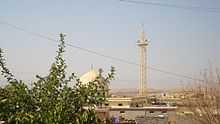Bardarash
Bardarash (Barda Rash) is a township (subdistrict) located in Iraqi Kurdistan Region, 70 km north of Irbil, the capital of Iraqi Kurdistan Region, and 32 km north east of Mosul. All its people are Kurds and Sunni Muslims and the majority of them speak in Gorani accent (not language), Goran is also the name of the tribe that comprises the majority of the people in Bardarash district. That is why the accent they are speaking is called Gorani as well.

History
At the era of Ottoman Empire, Bardarash was recognized as a district (Nahiya) in 1879. At the time of Ottoman empire and until 1970s, it was known as ‘Ashair Al Sab’aa, the meaning of which is "Seven Tribes" in English, because it is said that there are seven major tribes which lived and still live in Bardarash; they are - Rashgary 55%, Gezh 23%, Bot 11%, Shekh-Bzeni 2%, Khidiry 1%, Zangana 1% and others 7%. All of them are called Gorani. But also other tribes live in this area and some of them migrated in the four last decades of 20th century, such as Surchi, Zebar, Sharafan etc.[1]
Bardarash was formerly joined to Akre, and they were joined to Ninewa province until the Uprising of 1991, after which both towns were liberated from the Ba’ath regime and they were joined to Duhok province until now. In 2008 the KRG decided to create a new district (Qaza) centred on Bardarash.
One of the mosques of Bardarash
Etymology
Bardarash means "black stone"; this is because its soil in general is black or, there is a destination south of the Bardarash is called (Shaxe-Rash, Black-Rocks) and it’s said that people are used to live there before they transfer to current place.
Geography and population
Bardarash district is located between two rivers which they are (Upper- Zab, Zey Badinan) and (Xazir) in the east the west, and in north has a border with Akre and south with Mosul and Hawler. According to an (UN-WFP) censes in 1997 the population of Bardarash district was 51,713 people.[1] But now according to Bardarash Mayoralty, Bardarash now consists of three subjoined districts, which are Daratoo, Roviya, and Kalak, and 88 villages. The population of Bardarash now is more than 115,000 people. Sub-districts joined to Bardarash are 1- Daratoo 2- Rovia 3- Kalak [2]
A man from Bardarash wearing traditional clothes of the area
Economy
The area of Bardarash district according to some sources is 983 Square Kilometres. In general Bardarash is an agricultural area and until now most of the people depend on crop yields like wheat and barly. They used to have more sheep and cows than nowadays.
Bardarash is a rich area for oil resources and several foreign companies are now working on searching and producing oil. One of the companies has recently said that Bardarash is the second Kirkuk of Kurdistan for oil.
Social components
In Bardarash district the Goran tribe is dominant and they are subdivided into several smaller tribes. Tribal mentality has its biggest effect on the people of Bardarash and as a result of this mentality, there are some problems. As mentioned before there are several other tribes live in Bardarash, most of them came in 1975 when they migrated because of the Ba’ath toppled regime from Zumar, Atrush, Shexan, Rabee’a and Mreba and they were forced to settle in (Kanilan) village. After that Bardarash people took them and they divided to villages and many of them still live in Bardarash.[1]
Becoming a district
The ceremonies of turning Bardarash sub district into a district were performed in presence of Tamar Remezan, Duhok governor, the head of KDP branch (9), and a number of administrative and party officials and the dignitaries of the area. The mayor of Bardarash first gave a brief history of the sub district and the importance that KRG attached to the area after 1991, and he made it clear how important the decision to make Bardarash a district is. In his speech, the governor congratulated the people of the area and said that it is for the good of people that this decision was taken in order to give more attention to the area and promised to help improve the work of the administrative departments there. Mazin M. Saeed, the mayor, promised to do his best to provide services to the people. It is worth mentioning that Bardarash became a sub district in 1890 and more than 75000 people live in. It has two sub district (Kalak and Rovia), and another subdistrict is expected (Darato).[3]
Bardarash Uprising
On 12 March 1991 at 9 o’clock in the morning, Bardarash people like other Kurdish people in other parts of Kurdistan, started the uprising against Ba’ath regime and became the Gate of Uprising in Badinan, after that Akre and Duhok and Zaxo upraised against the regime and librated. As we said before 1991 Bardarash and Akre were joined to Mosul province but after the uprising, Bardarash and Akre were only two towns that upraised against Ba’ath Regime in Ninewa province and after that they joined to Duhok province and still managed by the KRG.
- ↑ 1.0 1.1 1.2 Yaseen Hasan Goran, Xazir Magazine, Issue 2 - 15
- ↑ Hangaw Organization For Cultural Development
- ↑ Bardarash becomes a district, from(Duhok governorate official website).

